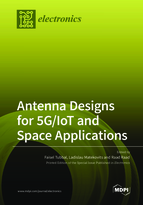Antenna Designs for 5G/IoT and Space Applications
A special issue of Electronics (ISSN 2079-9292). This special issue belongs to the section "Microwave and Wireless Communications".
Deadline for manuscript submissions: closed (31 May 2022) | Viewed by 66354
Special Issue Editors
Interests: antenna designs; CubeSat communications; wearable antennas; antenna designs using metamaterials and metasurfaces; wireless communications
Special Issues, Collections and Topics in MDPI journals
Interests: optimization techniques; numerical analysis; metamaterials; UWB antennas; reconfigurable antennas
Special Issues, Collections and Topics in MDPI journals
Interests: sensor networks; CubeSat; wireless communications; antenna design
Special Issues, Collections and Topics in MDPI journals
Special Issue Information
Dear Colleagues,
Antenna design has received renewed attention in the last few years. This is thanks to an explosion of interest in a range of applications, from Internet of Things, low frequency long-range applications to high-frequency mmWave 5G mobile technologies. There has also been renewed interest in wearable antennas that form body area networks. These include wearable garments as well as materials that directly attach themselves to skin, such as e-skin. In addition to this, a renewed interest in space and space exploration has renewed interest in satellite technologies and applications, such as CubeSats, intersatellite communications and deep space exploration. All these emerging applications bring a renewed interest in looking at special materials and new designs for antenna systems. This will bring new challenges in designing such antennas.
This Special Issue is intended to shed some light on recent advances in antenna design for these new emerging applications and identify further research areas in this exciting field of communications technologies. We invite researchers and practicing engineers to contribute original research articles that discuss issues related but not limited to:
- Antenna design for Internet of Things;
- Beamforming and smart antennas for 5G;
- Antenna design for wearable applications;
- Antenna design for body area networks;
- Antenna design for Chipless RFID;
- Metamaterial-based antennas;
- Smart antennas, beamforming and MIMO;
- Aeronautical and space applications;
- Antenna design for CubeSat;
- Antenna design for deep space communication
- Antenna design for biomedical systems and applications;
- Implanted antennas;
- UWB and multispectral technologies and systems;
- MM-wave and THz antennas.
Dr. Faisel Tubbal
Prof. Dr. Ladislau Matekovits
Dr. Raad Raad
Guest Editors
Manuscript Submission Information
Manuscripts should be submitted online at www.mdpi.com by registering and logging in to this website. Once you are registered, click here to go to the submission form. Manuscripts can be submitted until the deadline. All submissions that pass pre-check are peer-reviewed. Accepted papers will be published continuously in the journal (as soon as accepted) and will be listed together on the special issue website. Research articles, review articles as well as short communications are invited. For planned papers, a title and short abstract (about 100 words) can be sent to the Editorial Office for announcement on this website.
Submitted manuscripts should not have been published previously, nor be under consideration for publication elsewhere (except conference proceedings papers). All manuscripts are thoroughly refereed through a single-blind peer-review process. A guide for authors and other relevant information for submission of manuscripts is available on the Instructions for Authors page. Electronics is an international peer-reviewed open access semimonthly journal published by MDPI.
Please visit the Instructions for Authors page before submitting a manuscript. The Article Processing Charge (APC) for publication in this open access journal is 2400 CHF (Swiss Francs). Submitted papers should be well formatted and use good English. Authors may use MDPI's English editing service prior to publication or during author revisions.








